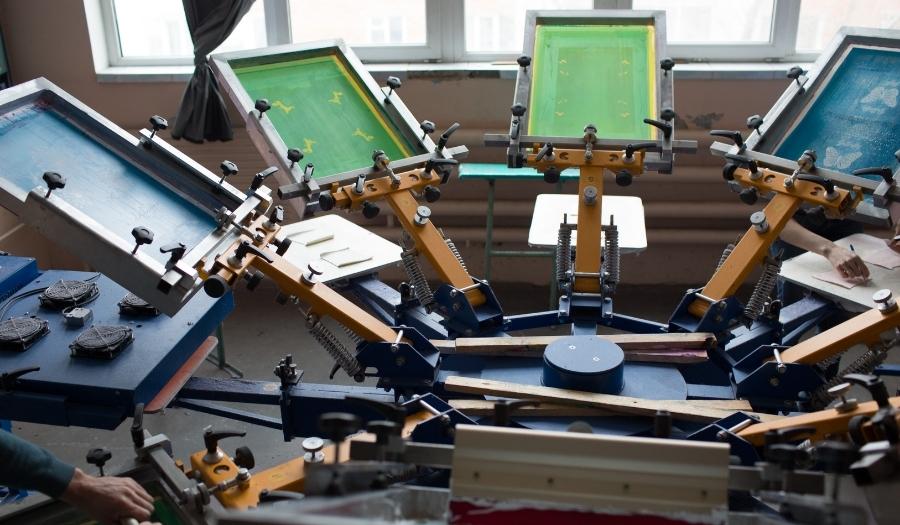Have you ever screen printed a job that looked great, but the shirt seemed stiff? This is often because the tension on the screen was too tight. This blog post will discuss the importance of screen tension in screen printing and how to achieve the perfect screen tension for your prints.
Why Is Screen Tension Essential?
Screen tension is the amount of force applied to the screen mesh by the frame. And it will play an important role in the quality of work that is produced. This tension is important because it determines how well the ink will transfer from the screen to the substrate.
If the tension is too low, the ink will not be able to pass through the screen and will result in a poor print. If the tension is too high, the screen will be more likely to break.
Screen tension also affects the registration of your prints. If the tension is too low, the print will be misaligned, and the print will be distorted if the tension is too high.
Adjust the Screen Tension to Get the Best Screen Printing Results Possible
To adjust the screen tension on your printer, you will need to use a screen tension meter. Screen tension meters come in both digital and analog models. However, we recommend using a digital model for more accurate readings.
First, you will need to loosen the screws that hold the screen in place. This helps to take the tension off the screen to measure the tension accurately.
Next, you will need to attach the tension meter to the screen. Once the tension meter is connected, you will need to slowly increase the tension on the screen until you reach the desired level.
Finally, you will need to re-tighten the screws that hold the screen in place. And that's it! You've now successfully adjusted the screen tension on your printer.
Screen tension is an essential factor in screen printing. By properly adjusting the tension on your screen, you can achieve better print quality and registration. We hope this blog post has helped you to better understand the importance of screen tension in screen printing. If you have any questions
What Are Some of the Problems if the Screen Tension Isn’t Set Correctly?
If the screen tension is too low, the ink will not be able to pass through the screen and will result in a poor print. If the tension is too high, the screen will be more likely to break. Screen tension also affects the registration of your prints.
If the tension is too low, the print will be misaligned, and the print will be distorted if the tension is too high. This is why it's crucial to have a screen tension meter and to adjust the screen tension on your printer correctly.
How Do I Know if My Screen Needs to Be Replaced?
If you notice that your screen is sagging or if the tension on your screen is not consistent, it may be time to replace it. We recommend replacing your screen every 1-2 years to ensure optimal print quality.
Screen tension is an essential factor in screen printing. By properly adjusting the tension on your screen, you can achieve better print quality and registration. Screen tension also helps to prolong the life of your screen. If you notice that your screen is sagging or if the tension on your screen is not consistent, it may be time to replace it. We recommend replacing your screen every 1-2 years to ensure optimal print quality.
How Does Screen Tension Degrade Over Time?
Screen tension degrades over time for several reasons. The most common reason is wear and tear. As the screen is used, the tension on the screen will gradually decrease.
Another reason for degradation is exposure to UV light. This can cause the screen mesh to become brittle and break. To prolong the life of your screen, we recommend storing your screen in a cool, dark place when it's not in use. This will help to prevent degradation and will help to keep the screen tension consistent.
Finally, humidity can also affect screen tension. If the humidity is too high, the screen will expand, and the tension will increase. If the humidity is too low, the screen will contract, and the tension will decrease.
It's important to check the screen tension on your printer regularly. We recommend checking the screen tension every six months to ensure that the tension is still at the desired level. By regularly checking and adjusting the screen tension on your screen, you can prolong the life of your screen and achieve better print quality.
How Does MicroScreen Solve These Issues?
Our ISO-9001:2015 Quality System and continual quality improvement processes are meant to help you 'tune' your screens to get the most out of your production operations.
We offer free evaluations to evaluate your work and make any necessary changes. Our screens solves problems and exceed expectations by:
- Allowing you to hold higher screen tensions for longer periods of time
- Reducing or eliminating screen contamination
- Enhancing the quality of your print
At each stage of manufacturing, we check and track the tension in the rope. A component of our inspection procedure is to make measurements on important features.
Have You Checked Your Screen Tension Recently?
Screen printing is an art. And it is an important part of your business, and you need to make sure you're using the best screen tension for your needs.
Microscreen LLC offers a variety of screen tension options to choose from. We have different types of screen tension that will improve screen performance.
Selecting the right screen tension will help you produce the best prints possible. Contact us today to learn more about our screen tension options!
